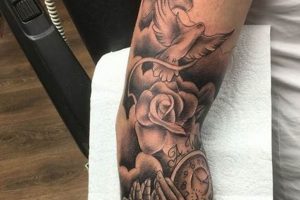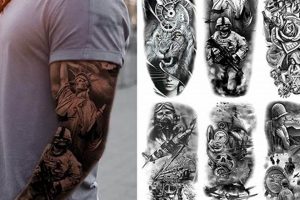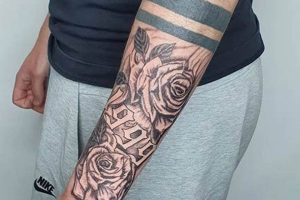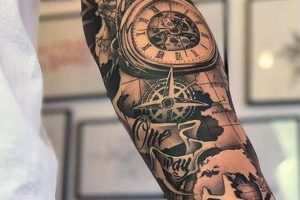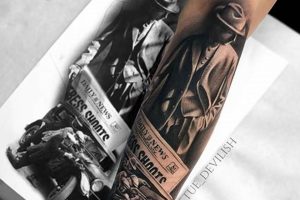A monochromatic aesthetic utilizing black ink and its diluted shades (grey) to create intricate body art that covers the arm, resembling a sleeve, represents a popular and enduring tattoo trend. This approach allows for detailed depictions of diverse subjects, ranging from realistic portraits and nature scenes to abstract patterns and geometric designs.
The enduring popularity of this style stems from its versatility and timeless quality. The use of black and grey creates a classic look that can suit various artistic styles and subject matters. Subtle shading and intricate details are achievable, adding depth and dimension to the overall design. Furthermore, black and grey tattoos generally age well, as the ink tends to fade more uniformly over time compared to colored tattoos.
This style offers a rich canvas for personal expression. The following sections will explore various themes and design elements commonly found within this style, offering inspiration and guidance for those considering a similar artistic commitment.
Tips for Black and Grey Tattoo Sleeves
Careful planning is essential for a successful and aesthetically pleasing full-sleeve tattoo. Consider these tips before committing to a design.
Tip 1: Research Artists: Seek artists specializing in black and grey realism, or the specific style desired. Examine portfolios for quality, consistency, and experience in similar projects.
Tip 2: Plan the Composition: Consider how individual elements will flow together across the entire arm. A cohesive narrative or visual theme creates a more impactful piece.
Tip 3: Value Contrast: Effective use of shading is paramount. Discuss contrast and the range of grey tones with the artist to ensure depth and visual interest within the design.
Tip 4: Size and Placement: Larger elements provide greater detail, while smaller details can add intricacy. Consider the natural curves and musculature of the arm when planning element placement.
Tip 5: Long-Term Commitment: A sleeve tattoo requires multiple sessions and represents a significant time investment. Be prepared for the process and choose a design that will remain meaningful over time.
Tip 6: Aftercare is Crucial: Follow the artist’s aftercare instructions diligently to ensure proper healing and ink retention. This protects the investment and ensures the longevity of the art.
Tip 7: Budget Appropriately: Large-scale tattoos require a substantial financial commitment. Discuss pricing with the artist upfront and factor in potential touch-up costs.
Careful consideration of these factors will contribute significantly to the success of a black and grey sleeve tattoo, ensuring a piece of art that is both visually striking and personally meaningful.
These tips provide a solid foundation for embarking on the journey of creating a lasting piece of body art. The next section will delve deeper into specific design considerations.
1. Theme
Theme selection serves as the foundational element for a cohesive and meaningful black and grey tattoo sleeve. It provides a unifying narrative, guiding the selection of imagery and dictating the overall composition. A well-defined theme ensures that individual elements work harmoniously, creating a visually compelling and conceptually resonant piece of art. Themes can range from broad concepts like nature or mythology to more personal narratives such as family history or life experiences. For example, a nature-themed sleeve might incorporate interconnected elements like forests, mountains, and animals, while a sleeve dedicated to a loved one might feature portraits, important dates, and symbolic representations of shared memories. The absence of a clear theme can result in a disjointed and less impactful design.
The theme’s influence extends beyond individual image selection. It informs the overall mood and atmosphere of the sleeve. A theme of darkness and despair might utilize imagery of skulls, ravens, and desolate landscapes, emphasizing deep blacks and stark contrasts. Conversely, a theme of hope and renewal might incorporate blossoming flowers, celestial bodies, and flowing water, utilizing softer shading and a gentler aesthetic. A clear theme also facilitates communication between the client and the tattoo artist, ensuring a shared vision and a more successful outcome. The artist can better understand the client’s intentions and offer informed design suggestions that align with the chosen theme.
Ultimately, the theme acts as the backbone of a successful black and grey tattoo sleeve. It provides structure, meaning, and artistic direction, transforming a collection of individual images into a unified and powerful statement. Careful consideration of the theme is therefore paramount, as it determines the overall aesthetic impact and lasting significance of the tattoo. Challenges can arise when a theme is too broad or lacks personal resonance, leading to a less impactful design. A strong theme, however, provides a framework for a cohesive and meaningful piece of art that will resonate with the wearer for years to come.
2. Imagery
Imagery forms the visual core of black and grey tattoo sleeves, translating thematic concepts into tangible artistic representations. Careful image selection is crucial, ensuring thematic resonance and visual harmony across the entire composition. The interplay of chosen images creates a narrative, conveying meaning and evoking emotion through visual storytelling. For example, a sleeve exploring themes of mortality might incorporate imagery of skulls, hourglasses, or wilting flowers, each element contributing to the overall narrative of life’s transient nature. Conversely, a sleeve celebrating life might feature vibrant imagery of flourishing flora, dynamic animal portraits, or symbolic representations of growth and renewal.
Effective imagery considers not only individual elements but also their relationships and placement within the overall composition. A skilled artist can create a sense of flow and interconnectedness, weaving images together seamlessly across the contours of the arm. The size and placement of each element contribute to the overall visual impact. Larger, focal images can anchor the design, while smaller, supporting details add depth and complexity. Consider a sleeve depicting a Japanese dragon: the dragon itself might serve as the central, dominant image, while surrounding elements like cherry blossoms, waves, or clouds create context and enhance the narrative. The grayscale palette allows for subtle nuances in shading and texture, adding depth and realism to the imagery.
The power of imagery in black and grey tattoo sleeves lies in its ability to convey complex ideas and emotions through visual language. Successful imagery choices result in a cohesive and impactful design that resonates with the wearer and viewer alike. Challenges arise when imagery clashes thematically or lacks visual coherence, potentially undermining the intended narrative. Understanding the importance of imagery selection and its impact on the overall composition is essential for creating a meaningful and aesthetically compelling piece of body art.
3. Composition
Composition acts as the architectural blueprint for black and grey tattoo sleeves, dictating the arrangement and interplay of visual elements. A well-considered composition elevates individual images into a cohesive and visually compelling narrative. It determines how the eye travels across the design, guiding the viewer through the intended story. Compositional elements like flow, balance, and negative space contribute significantly to the overall impact and aesthetic harmony of the sleeve. Consider a nature-themed sleeve: strategic placement of mountains, forests, and waterfalls can create a sense of depth and perspective, guiding the viewer’s gaze across the landscape depicted on the arm. A poorly planned composition, however, can result in a cluttered and visually confusing design, regardless of the quality of individual images.
Effective composition considers the three-dimensional canvas of the body. The curves and contours of the arm influence image placement and flow. Elements should complement the body’s natural shape, creating a seamless integration of art and anatomy. For instance, a swirling design might follow the natural curvature of the bicep, while a vertical arrangement of elements might accentuate the length of the forearm. Furthermore, skillful use of negative space provides breathing room within the composition, preventing visual overload and enhancing the impact of key elements. In a portrait sleeve, strategically placed negative space can isolate and emphasize the subject’s features, enhancing the overall realism and emotional impact.
Successful composition in black and grey tattoo sleeves relies on a balance between visual harmony and dynamic tension. A static, overly symmetrical composition can lack visual interest, while an overly chaotic composition can appear fragmented and disjointed. The goal is to create a design that is both aesthetically pleasing and engaging, drawing the viewer in and encouraging exploration of the narrative depicted. Challenges in composition often stem from a failure to consider the overall design, focusing solely on individual images rather than their interconnectedness. A strong composition, however, transforms disparate elements into a unified and powerful work of art, enhancing the aesthetic appeal and lasting significance of the tattoo.
4. Placement
Placement plays a critical role in the overall impact and effectiveness of black and grey tattoo sleeves. Strategic placement considers both the visual flow of the design and the anatomical contours of the arm. It influences how the narrative unfolds and how individual elements interact with the body’s natural form. A well-planned placement scheme enhances the visual impact and contributes to the longevity of the tattoo’s aesthetic appeal. For example, a dynamic composition might place key elements along the natural muscle lines of the arm, accentuating the body’s form and creating a sense of movement within the design. Conversely, poor placement can disrupt visual flow, making the design appear disjointed and awkward. A large, intricate design element placed on a small, curved area like the inner elbow might distort the image and diminish its impact.
Consider a sleeve depicting a scene from nature. Mountains might be strategically placed along the shoulder and upper arm to create a sense of scale and grandeur, while a flowing river might wind its way down the forearm, following the natural curve of the arm. Alternatively, a portrait-based sleeve might position the primary portrait on the outer forearm, a highly visible and relatively flat surface ideal for showcasing intricate details. Supporting elements, like symbolic objects or background details, can then be placed around the central portrait, enhancing the narrative and visual interest. Placement also affects how the tattoo ages. Areas with greater skin movement and sun exposure, like the outer forearm and hands, may experience faster ink fading compared to less exposed areas like the inner bicep.
Understanding the importance of placement ensures the tattoo design integrates harmoniously with the body, maximizing its visual impact and longevity. Challenges in placement arise when anatomical considerations are overlooked or when the design’s flow disregards the body’s natural curves. Careful planning and collaboration with a skilled artist are crucial for optimizing placement, resulting in a cohesive and visually compelling piece of body art that remains aesthetically pleasing for years to come.
5. Artist Skill
Artist skill is paramount in realizing successful black and grey tattoo sleeves. This intricate style demands a high level of technical proficiency and artistic vision. Mastery of shading, line work, and composition are essential for translating complex designs into compelling body art. The artist’s ability to create smooth transitions between shades of grey, capturing depth and dimension, is crucial for realism and visual impact. Precise line work defines shapes and adds detail, while a strong understanding of composition ensures visual harmony across the entire sleeve. An artist’s experience with different needle sizes and techniques allows for varying textures and effects, crucial for achieving desired aesthetic outcomes. For instance, a skilled artist can create the illusion of fur on an animal portrait or the rough texture of bark on a tree, adding depth and realism to the overall design.
Choosing an artist specializing in black and grey realism is crucial. Portfolios should be reviewed carefully, paying attention to the artist’s consistency, attention to detail, and ability to execute complex designs. Experience in specific subject matter, such as portraits, nature scenes, or geometric patterns, should align with the desired theme and imagery. An artist with a strong understanding of anatomy can create realistic and dynamic human figures, while an artist specializing in botanical illustration can render intricate floral designs with precision and accuracy. Furthermore, effective communication between the client and the artist is essential for a successful outcome. A skilled artist will actively listen to the client’s vision, offering expert advice and guidance throughout the design process. This collaborative approach ensures the final tattoo reflects the client’s desires while benefiting from the artist’s technical expertise and artistic sensibilities.
Ultimately, artist skill significantly impacts the longevity and aesthetic quality of a black and grey tattoo sleeve. A skilled artist creates a piece of art that not only captures the intended design but also ages gracefully over time. Challenges arise when inexperienced artists attempt complex designs, potentially resulting in uneven shading, blurred lines, and a less impactful overall composition. Investing time in researching and selecting a qualified artist represents a crucial step in ensuring a successful and enduring piece of body art.
6. Aftercare
Diligent aftercare is inextricably linked to the long-term success and aesthetic preservation of black and grey tattoo sleeves. This intricate art form, characterized by subtle gradations of black ink and delicate shading, requires meticulous care during the healing process to ensure the intended artistic vision remains vibrant and intact. Neglecting proper aftercare can compromise the integrity of the design, leading to ink fading, blurring, and infection, ultimately diminishing the impact and longevity of the tattoo. For example, failing to keep the tattoo clean and moisturized can lead to scabbing and ink loss, resulting in patchy areas and distorted lines. Proper aftercare, including regular cleaning with mild soap and application of fragrance-free moisturizer, minimizes these risks and promotes optimal healing.
Specific aftercare practices can further enhance the vibrancy and longevity of black and grey tattoos. Avoiding prolonged sun exposure, particularly during the initial healing phase, protects the delicate greywash tones from fading. Sunblock application, once the tattoo is fully healed, remains crucial for long-term preservation. Additionally, avoiding harsh chemicals and abrasive materials on the tattooed area prevents irritation and potential damage to the ink. For instance, swimming in chlorinated pools or using perfumed lotions can irritate the skin and fade the tattoo. Choosing appropriate clothing, avoiding tight-fitting garments that rub against the fresh tattoo, also minimizes the risk of complications and promotes optimal healing. These practices, while seemingly minor, contribute significantly to the overall aesthetic and longevity of the tattoo sleeve.
Ultimately, aftercare forms an integral component of the entire tattoo process, directly impacting the final result and long-term satisfaction with a black and grey sleeve. Challenges in aftercare often arise from misinformation or a lack of understanding regarding the healing process. A collaborative relationship with a reputable tattoo artist, including clear aftercare instructions and ongoing support, empowers individuals to protect their investment and maintain the artistic integrity of their tattoos for years to come. This commitment to aftercare ensures that the intricate details and subtle shading, characteristic of this style, remain vibrant and captivating, preserving the intended artistic expression.
Frequently Asked Questions
This section addresses common inquiries regarding black and grey tattoo sleeves, providing clarity and guidance for those considering this artistic commitment.
Question 1: How much does a black and grey tattoo sleeve typically cost?
Cost depends on several factors, including artist experience, design complexity, and geographic location. Large-scale projects like sleeves require significant time investments, often spanning multiple sessions. Researching artists and discussing pricing upfront is crucial for budgeting appropriately.
Question 2: How long does a black and grey tattoo sleeve take to complete?
Completion time varies based on design intricacy and individual pain tolerance. Sleeves typically require multiple sessions, each lasting several hours, spaced weeks apart to allow for healing. Complex designs with intricate details may require more sessions, extending the overall completion time.
Question 3: Does a black and grey tattoo sleeve hurt more than other tattoo placements?
Pain perception is subjective. However, certain areas of the arm, such as the inner elbow and wrist, possess thinner skin and increased nerve endings, potentially leading to heightened sensitivity. Discussing pain management strategies with the artist can help mitigate discomfort during the process.
Question 4: How does one choose the right artist for a black and grey tattoo sleeve?
Thorough research is essential. Examine artist portfolios, focusing on experience with black and grey realism and similar projects. Seek artists specializing in the desired style and subject matter. Consultations and discussions regarding artistic vision and technical approach are crucial for ensuring compatibility.
Question 5: What are the key considerations for aftercare of a black and grey tattoo sleeve?
Following the artist’s aftercare instructions diligently is paramount. Proper cleaning, moisturizing, and sun protection are essential for optimal healing and ink retention. Avoiding harsh chemicals and abrasive materials minimizes the risk of complications and preserves the tattoo’s long-term aesthetic quality.
Question 6: Can a black and grey tattoo sleeve be covered up or removed in the future?
Cover-ups and removals are possible but present significant challenges. Black and grey tattoos, particularly those with dense shading, can be difficult to cover effectively. Laser removal is an option but often requires multiple sessions and may not completely eliminate the ink. Careful consideration of design choices and long-term implications is essential before committing to a large-scale tattoo.
Careful consideration of these factors contributes significantly to the success and longevity of black and grey tattoo sleeves. Thorough planning, artist selection, and diligent aftercare are crucial for ensuring a satisfying and enduring piece of body art.
The subsequent sections delve further into specific design elements and inspiration for black and grey tattoo sleeves.
Conclusion
Exploration of monochromatic arm-covering artwork reveals a rich tapestry of themes, imagery, and artistic techniques. Careful consideration of composition, placement, and artist skill ensures a cohesive and impactful design. Diligent aftercare preserves the intricate details and subtle shading, safeguarding the artistic investment and maximizing longevity.
Body art represents a powerful form of self-expression. Thorough planning and informed decision-making transform ephemeral ideas into enduring personal narratives etched onto the skin. The commitment to quality, from concept to execution and aftercare, ensures these narratives remain vibrant and meaningful for years to come.



